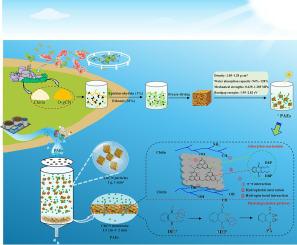Separation and Purification Technology ( IF 8.1 ) Pub Date : 2023-11-04 , DOI: 10.1016/j.seppur.2023.125586 Cuizhu Sun , Zhenggang Wang , Hao Zheng , Shasha Zhao , Xianxiang Luo , Chenguang Li , Lingyun Chen , Fengmin Li

|
Phthalate esters (PAEs) widely used as plasticizers in industrial products are a major threat to human health and water ecological security. In this work, chitin-based sponges doped with oxygen-modified graphitic carbon nitride (O-gCN) (ChCN) demonstrated adsorption-photocatalytic synergistic ability for the efficient removal of two typical PAEs, diethyl phthalate (DEP) and dibutyl phthalate (DBP). The addition of O-gCN increased the sponge mechanical strength from 0.629 to 1.39 MPa, enabling materials with interconnected pores, excellent compressibility, and mechanical durability. The saturated adsorption capacities of DEP and DBP reached 37.41–42.93 mg g−1 for ChCN sponges, wherein the driving forces were hydrophobic interactions, hydrogen bonding, and π-π interactions. Notably, O-gCN significantly improved PAE removal by simultaneously enhancing the adsorption and photocatalytic effect of ChCN sponges due to its high catalytic activity, leading to 100% removal of DEP and DBP within 2 h. The degradation pathway of DEP was confirmed to be de-esterification. Finally, filtration columns assembled with ChCN sponges showed 87.8–90.9% PAE removal from water under natural light, and the removal efficiency did not significantly change even after three reuses, indicating stable removal performance and good reusability with potential for practical applications. The sponges also possessed good biocompatibility and biodegradability, as demonstrated through algal toxicity experiments and biodegradation tests. Therefore, this research presents a convenient method for preparation of compressible and reusable sponge materials from renewable biomass for efficient PAE removal from aqueous environments and has revealed the underlying mechanisms of such removal by the adsorption-photocatalysis synergistic effect.
中文翻译:

合成可压缩且可重复使用的甲壳素/O-gCN海绵,用于有效去除水环境中的邻苯二甲酸酯
邻苯二甲酸酯(PAE)在工业产品中广泛用作增塑剂,对人类健康和水生态安全构成重大威胁。在这项工作中,掺杂氧改性石墨氮化碳(O- g CN)(ChCN)的甲壳素海绵表现出吸附-光催化协同能力,可有效去除两种典型的PAE:邻苯二甲酸二乙酯(DEP)和邻苯二甲酸二丁酯(DBP) )。O- g CN的添加将海绵的机械强度从0.629 MPa提高到1.39 MPa,使材料具有连通的孔隙、优异的压缩性和机械耐久性。ChCN海绵对DEP和DBP的饱和吸附容量达到37.41-42.93 mg g -1,其中驱动力为疏水相互作用、氢键和π-π相互作用。值得注意的是,O- g CN 由于其高催化活性,同时增强了 ChCN 海绵的吸附和光催化效果,显着提高了 PAE 去除率,导致 DEP 和 DBP 在 2 小时内 100% 去除。证实DEP的降解途径为脱酯化。最后,用ChCN海绵组装的过滤柱在自然光下对水中的PAE去除率达到87.8-90.9%,并且即使重复使用3次后,去除效率也没有显着变化,表明去除性能稳定,可重复使用性良好,具有实际应用的潜力。通过藻类毒性实验和生物降解试验证明,海绵还具有良好的生物相容性和生物降解性。因此,本研究提出了一种利用可再生生物质制备可压缩且可重复使用的海绵材料的便捷方法,以有效去除水环境中的PAE,并揭示了通过吸附-光催化协同效应去除PAE的潜在机制。


















































 京公网安备 11010802027423号
京公网安备 11010802027423号